close
Choose Your Site
Global
Social Media
Views: 0 Author: Site Editor Publish Time: 2025-07-15 Origin: Site











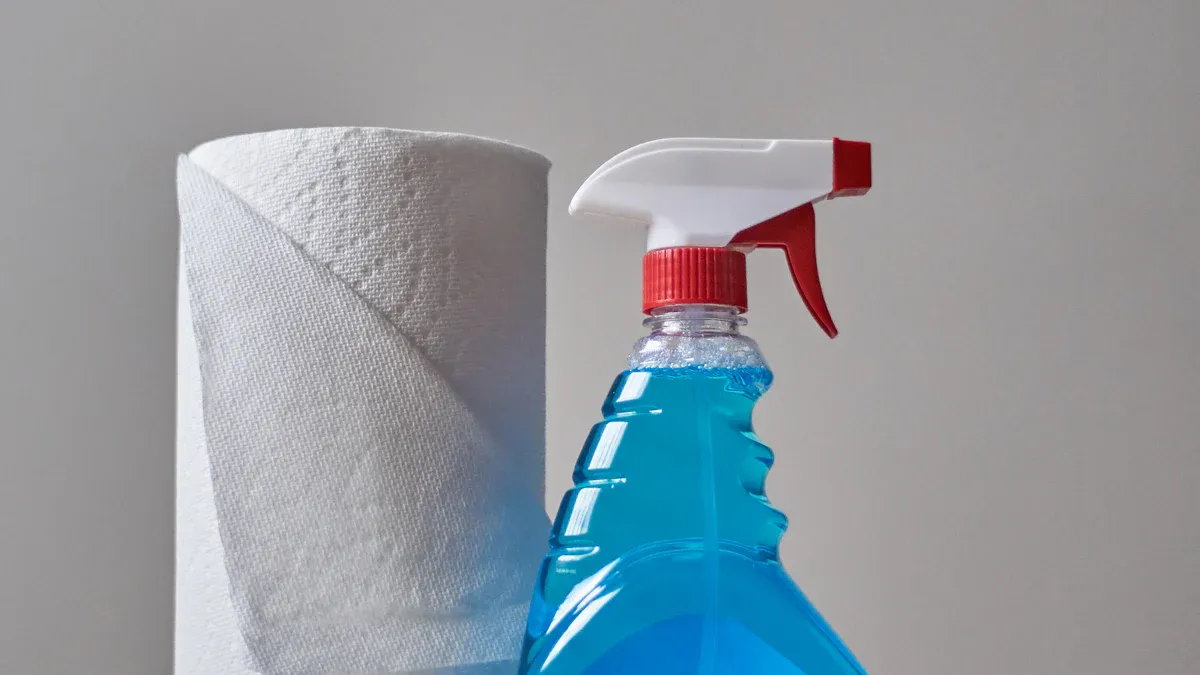
You use paper towels and tissues every day, but they are not the same. Paper towels are tough and soak up spills well. Tissues are soft and made for your skin or nose. It is important to know how they are different. This helps you pick the right one and not make mistakes. For example, do not use toilet paper to clean tables. Do not use paper towels on your face. People want these products more and more around the world. The chart below shows how important they are in homes and businesses.
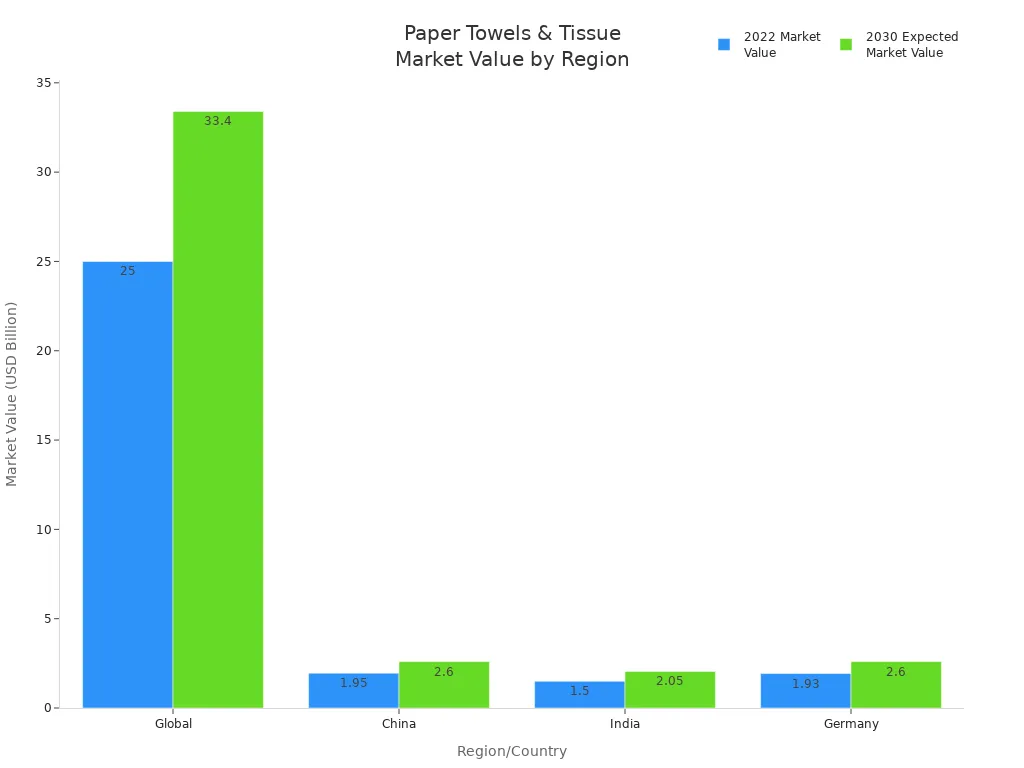
Paper towels are thick and strong. They soak up liquid well. This makes them great for cleaning spills. They are also good for drying hands.
Tissues feel soft and gentle. They are made for your nose, face, and hands. But they are not strong for cleaning messes.
Use paper towels for cleaning jobs. Use tissues for personal care. This helps you stay comfortable. It also stops plumbing problems.
Only flush toilet paper in the toilet. Do not flush paper towels or tissues. They can block pipes. This can lead to expensive repairs.
Pick eco-friendly products with recycled materials. Look for the right labels. This helps the environment. It can also save you money.
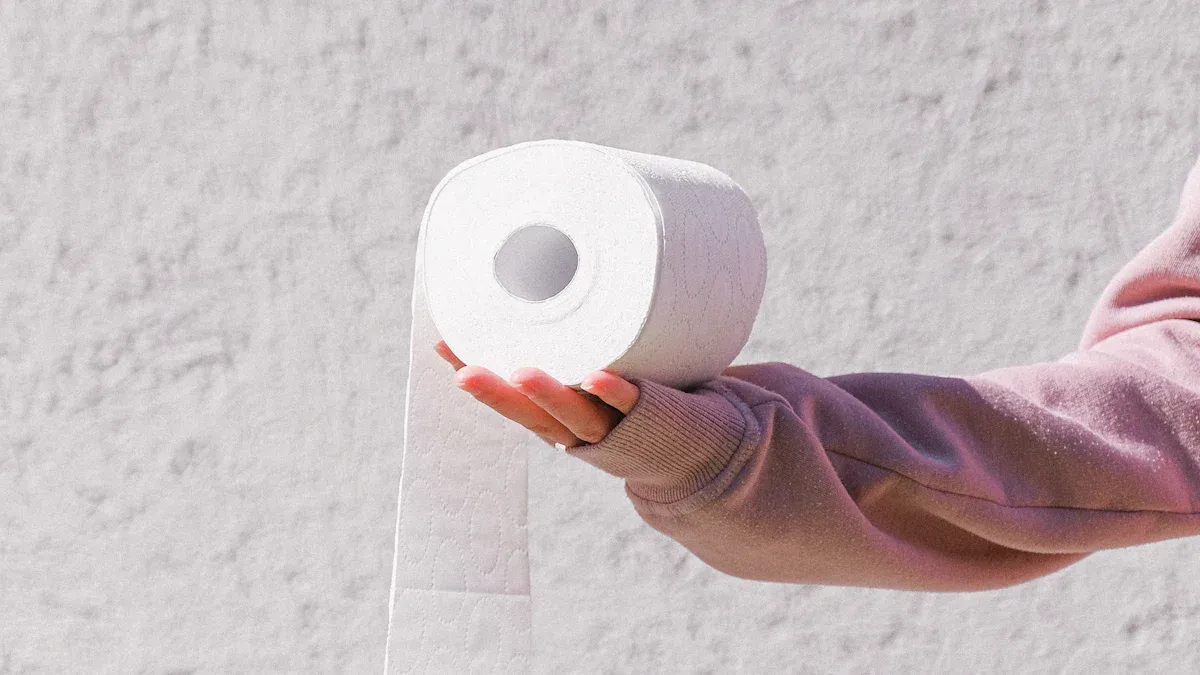
People use paper towels to clean up messes or dry hands. They are made from wood pulp fibers. Most companies pick long softwood fibers for strength. Some brands add recycled pulp or bamboo to help the planet. Wet-strength agents are used so paper towels do not break when wet. Paper towels feel thick and strong. This is because two sheets are joined together. Embossing adds texture. Light pressing keeps them able to soak up liquid.
Paper towels prioritize strength and absorbency through specific material choices:
Fiber Selection: Primarily use long softwood fibers (2.5-4.0mm) like pine/spruce for tensile strength.
Additives: Incorporate wet-strength resins (e.g., polyamide-epoxy) to maintain integrity when wet.
Eco-Options: 30-50% recycled pulp or bamboo pulp variants reduce deforestation impact.
Jumbo Roll Specs:
Basis weight: 30-50 gsm
Width: 2750-2850mm
Embossing patterns increase liquid capacity by 40%.
Tip: Use paper towels to clean wet surfaces. They stay together and soak up spills fast.
Here is a table that lists the main raw materials for paper towels and tissues:
| Raw Material Source | Description | Fiber Characteristics and Differences |
|---|---|---|
| Wood Pulp | Comes from softwood and hardwood trees | Softwood pulp: long fibers for strength; Hardwood pulp: short fibers for softness |
| Agricultural Residues | Includes bagasse, straw, bamboo | Good for the environment; fibers are rich in cellulose |
| Recycled Paper | Made from waste paper | Saves resources; fiber quality depends on where it comes from |
Tissues are made for your face and hands. They must be soft and gentle. Most tissues use only virgin wood pulp. Short hardwood fibers make them smooth. Huaxin Global Co., Ltd. sells tissue paper raw materials. Their jumbo rolls use FSC-certified virgin wood pulp. You can pick the GSM, ply, width, and embossing. These tissues break down in water and have no added scents or brighteners. The company recycles most of its water and uses biomass energy. This makes their tissues good for the earth.
You can buy tissues with different fiber mixes. Some have anti-bacterial features or logo embossing. Special machines make thin, soft sheets. Tissues break apart in water, so they are safe for hygiene. They meet ISO, SGS, and FDA rules. This means they are safe and clean.
Tissues focus on skin safety and rapid dissolution:
Fiber Composition: Short hardwood fibers (1.2-2.5mm) like eucalyptus/birch enhance softness.
Chemical-Free: Minimal additives to prevent skin irritation; FSC-certified virgin pulp common.
Rapid Dissolution: Low wet-strength formulation breaks down in <2 minutes (vs. >30 min for paper towels).
Jumbo Roll Standards:
Basis weight: 14.5-30 gsm
Customizable ply/width options
Perforation/embossing during converting.
Jumbo Roll Parameter Comparison:
| Parameter | Tissue Jumbo Rolls | Paper Towel Jumbo Rolls | Functional Impact |
|---|---|---|---|
| Basis Weight | 14.5-30 gsm | 30-50 gsm | Thickness/liquid capacity |
| Fiber Length | 1.2-2.5mm (hardwood) | 2.5-4.0mm (softwood) | Wet tensile strength |
| Creping Rate | 20-30% | 15-25% | Softness vs absorbency |
| Wet Strength | 3-8 N/m | 15-30 N/m | Plumbing safety vs durability |
Note: Tissues are best for your nose, face, or hands. They are not strong enough to clean up spills like paper towels.
Both tissues and paper towels come from wood pulp. The fiber type and how they are made make them different. Paper towels are thick and strong. Tissues are soft and gentle. Each one is made for a special job.
When you look at paper towels and tissues, you notice clear differences in thickness and size. Paper towels usually come in larger sheets. You often find them in rolls that fit kitchen dispensers. Each sheet feels thick and sturdy. This design helps you clean up big messes. The thickness also makes them more absorbent, so you can wipe up spills without the sheet falling apart.
Tissues, on the other hand, are much thinner. You find them in small boxes or pocket packs. Each sheet is light and soft. The size fits your hand or face perfectly. Tissues are not made for scrubbing or cleaning surfaces. Instead, they work best for wiping your nose or face. Their thin design helps them break down quickly in water, making them safe to flush.
Here is a quick comparison:
| Feature | Paper Towels | Tissues |
|---|---|---|
| Sheet Size | Large | Small |
| Thickness | Thick | Thin |
| Absorbent Level | High | Moderate |
| Best Use | Cleaning, drying hands | Nose, face, light use |
Tip: Use paper towels for kitchen messes. Use tissues for your nose or face.
You want softness when you use tissues on your skin. Manufacturers use special fibers and processing steps to make tissues gentle and smooth. The softness comes from short fibers and high porosity. This makes tissues feel nice but also means they are less strong. If you try to clean a spill with tissues, they may tear or fall apart.
Paper towels focus on strength. They use longer fibers and special bonding methods. This gives you a tough, absorbent sheet that holds up when wet. Industry labs test both products for softness and strength. They use machines to measure how much force it takes to tear a sheet or how soft it feels to the touch. These tests show that tissues score high for softness, while paper towels score high for strength and absorbent power.
You can see the trade-off:
Tissues: Very soft, gentle, less strong, moderately absorbent.
Paper towels: Strong, thick, very absorbent, less soft.
Note: Choose tissues for comfort and paper towels for cleaning power. Each product is designed for its own job.
Parent rolls undergo critical converting processes:
Slitting/Rewinding: Jumbo rolls cut to consumer sizes (e.g., 110mm toilet rolls, 230mm paper towel rolls).
Embossing/Perforating: Diamond or dot patterns increase surface area; precision perforations enable clean tearing.
Ply Bonding: 2-3 ply tissues use adhesive-free through-air bonding; paper towels employ resin bonding for scrub resistance.
| Test Metric | Paper Towels | Tissues | Industry Standard |
|---|---|---|---|
| Water Absorption | 0.4-0.5oz in 20s | 0.2-0.3oz in 20s | ASTM D5729 |
| Wet Burst Strength | 35-50 kPa | 5-10 kPa | TAPPI T403 |
| Dissolution Time | >30 minutes | <2 minutes | INDA/EDANA GD4 |
Expert Tip: Paper towels achieve 80% higher cleaning efficiency on non-porous surfaces, while tissues reduce facial friction by 60% compared to paper towels.

When you compare paper towels vs tissues, absorbency stands out as one of the most important differences. Paper towels have high absorbency because manufacturers design them to soak up spills quickly. You can see this in real-world tests. Leading paper towel brands like Bounty and Viva need only two sheets to clean up a third of a cup of water. In contrast, tissue paper products such as Kleenex Multi-Fold require four sheets, and Scott Essential needs about six sheets for the same spill.
Here is a table that shows a direct comparison of absorbency rates:
| Brand | Water Diffusion (inches in 20s) | Sheets to Clean 1/3 Cup Spill | Water Absorbed (oz in 20s, 4x4 inch) |
|---|---|---|---|
| Seventh Generation | 2.9 | 2.75 | 0.4 |
| Bounty | 2.5 | 2 | 0.4 |
| Viva Multi-Surface | 2.5 | 2 | 0.4 |
| Brawny Tear-A-Square | 2.35 | 2.5 | 0.5 |
| Presto! | 2.4 | 3 | 0.4 |
| Sparkle | 2.25 | 3 | 0.5 |
| Kleenex Multi-Fold | 2.41 | 4 | 0.3 |
| Scott Essential | 1.9 | 6 | 0.3 |
| Pacific Blue Basics | 1.0 | ~36 (approx. 3 feet) | 0.2 |
You can also see the results in this chart:
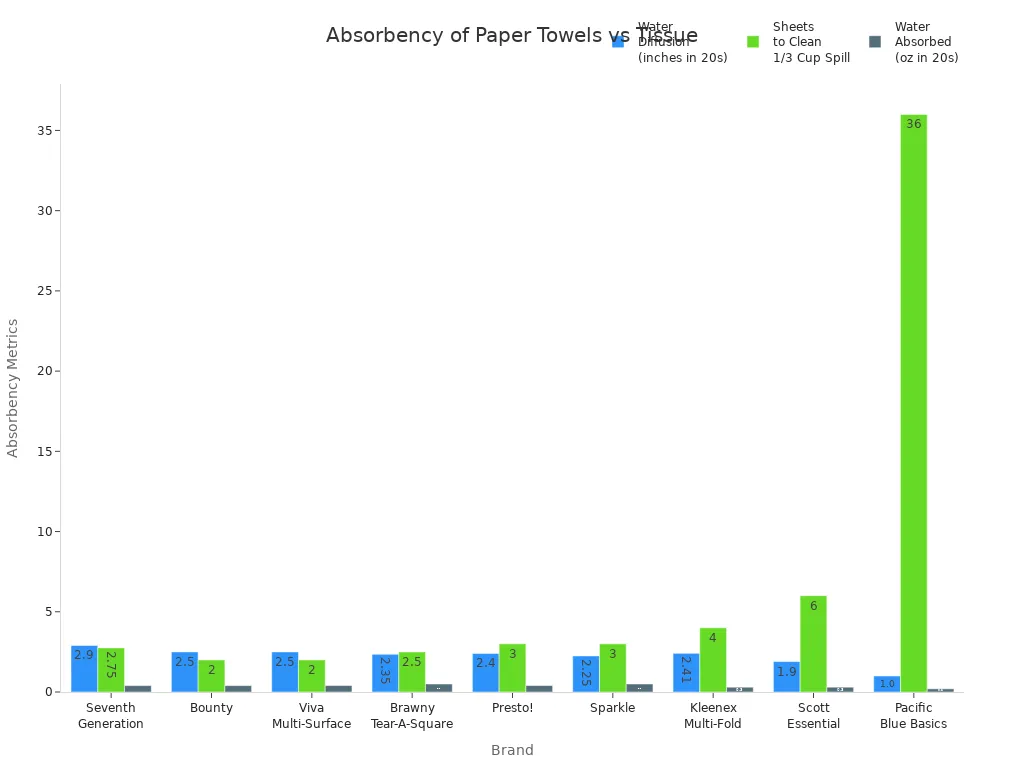
Paper towels are highly absorbent and transport water faster than tissues. This means you need fewer sheets to clean up a mess. Tissues do absorb water, but not as much or as quickly. If you want high absorbency for cleaning, paper towels work best. For wiping your nose or face, tissues provide enough absorbency without being too thick.
Tip: Use paper towels for spills and cleaning. Choose tissues for gentle tasks like wiping your face.
Durability matters when you need a product that stays strong, especially when wet. Paper towels use long fibers and special resins to keep their strength even after soaking up water. Standardized tests show that paper towels keep their structure and do not fall apart, even after long periods in water. This happens because manufacturers add crosslinking resins that give permanent wet strength.
Tissue paper, on the other hand, has only temporary wet strength. It starts to break down soon after getting wet. This makes tissues safe to flush, but not good for scrubbing or cleaning. If you try to wipe a countertop with tissues, you will notice they tear easily. Paper towels hold up much better for tough jobs.
Here is a quick list to help you remember:
Paper towels: Stay strong when wet, good for scrubbing, do not tear easily.
Tissues: Break down quickly in water, best for light use, not for cleaning surfaces.
Note: For cleaning and wiping wet surfaces, always pick paper towels. For gentle use, tissues are enough.
Comfort plays a big role in your choice between paper towels vs tissues. Tissues feel soft and gentle on your skin. Manufacturers use short fibers and special processing to make tissues smooth and comfortable. You can use them on your nose or face without irritation.
Paper towels focus on strength and absorbency, not softness. They feel rougher and thicker. If you use paper towels on your face, you might feel discomfort or even redness. For comfort, tissues win every time.
Here is a direct comparison:
| Feature | Paper Towels | Tissues |
|---|---|---|
| Comfort Level | Low to moderate | High |
| Best Use | Cleaning, drying hands | Nose, face, gentle use |
Reminder: Always use tissues for your face or nose. Save paper towels for cleaning and drying tasks.
Almost every home and business has paper towels. People use them to clean, dry hands, and wipe surfaces. In the kitchen, you grab a paper towel to clean up spills or dry fruit and veggies. Restaurants, hotels, and hospitals need paper towels to keep things clean and safe. These places use them to stop germs from spreading. Rolled paper towels are in public restrooms because they are simple to use and help keep things tidy.
Here are some ways people use paper towels:
Wiping kitchen counters and tables
Drying hands after washing
Cleaning up spills and messes
Polishing glass and mirrors
Absorbing oil from fried foods
Most paper towels are used at home, but businesses are using more too. Some people pick reusable cloths or reuse paper towels. This helps save money and is better for the earth.
Tip: Use a new paper towel for each job. This helps stop germs from spreading.
Tissues have many uses in your daily life. You use them for personal care, like blowing your nose or wiping your face. In restaurants and cafes, tissue napkins help keep hands and mouths clean. Offices, hotels, and healthcare centers use tissues to keep guests and patients comfortable and clean.
Look at this table for common ways to use tissue paper:
| Setting | Main Uses |
|---|---|
| Home | Facial tissues, toilet paper, napkins |
| Restaurants & Cafes | Napkins, hand wipes |
| Offices & Hotels | Facial tissues, guest napkins |
| Healthcare Facilities | Patient care, infection control |
| Public Restrooms | Toilet paper, hand wipes |
You see tissues everywhere because they are soft, easy to throw away, and gentle on skin. More people want eco-friendly and high-quality tissues, especially in places that care about being clean.
You might wonder if you can flush paper towels like toilet paper. Experts say only flush toilet paper. Toilet paper breaks down fast in water, so it does not clog pipes. Paper towels and tissues do not break down as quickly. If you flush them, they can block pipes and cost a lot to fix.
Toilet paper is soft and safe for your skin. It falls apart in water in just a few minutes. Paper towels stay strong when wet. This makes them good for cleaning but bad for plumbing. Even if something says “flushable,” it may not break down like toilet paper. Always throw paper towels and tissues in the trash, not the toilet.
Note: To protect your pipes and the planet, only flush toilet paper. Use paper towels for cleaning and tissues for personal care.
You want the right product for your cleaning tasks. Paper towels give you strong cleaning power. You can use them to wipe up spills, scrub surfaces, and dry your hands. The thick sheets hold together when wet. This makes them perfect for tough cleaning jobs in the kitchen or bathroom. When you need to clean up grease or sticky messes, paper towels work best. You can use them for cleaning windows, wiping counters, or drying dishes. Many people choose paper towels for cleaning tasks because they do not tear easily.
Tissue paper feels soft and gentle. You use it for light cleaning tasks, like wiping your nose or face. It works well for small spills or dust, but it breaks apart if you try to scrub. You should not use tissues for heavy cleaning. They are not strong enough for cleaning tasks that need scrubbing or soaking up a lot of liquid. If you want comfort for your skin, tissues are the better choice. For most cleaning tasks around your home, paper towels give you better results.
Tip: Use paper towels for cleaning tasks that need strength. Use tissues for gentle cleaning on your skin.
You need to think about plumbing safety when you choose between paper towels and tissue paper. Many city guidelines and experts warn you to flush only toilet paper. Paper towels do not break down in water. If you flush them, they can clog your pipes. Studies from Michigan State University Extension and city sanitation districts show that paper towels cause many plumbing problems. In Portland, Maine, research found that 40% of pipe clogs come from paper products other than toilet paper. These clogs lead to expensive repairs and damage to septic systems.
Municipal guidelines from places like the California Water Environment Association say you should never flush paper towels or wipes. Even if a product says “flushable,” it may not break down fast enough. These items can block sewer systems and cause backups. You should always throw paper towels and wipes in the trash. Only flush the “three P’s”: pee, poop, and toilet paper. This simple rule keeps your plumbing safe and protects the environment.
Pipe Blockage Risks: Paper towels cause 40% of non-flushable clogs due to high wet strength (15-30 N/m).
Safe Disposal: Only toilet paper (3-8 N/m wet strength) meets <10-minute dissolution standards for flushing.
Note: Protect your pipes and avoid costly repairs. Always use the trash for paper towels after cleaning tasks.
**100% Virgin Wood Pulp Jumbo Rolls: Sustainably sourced from FSC-certified forests (20-80 year rotation cycles); carbon-neutral lifecycle with 3.8-4.2g CO₂/unit emissions via biomass energy utilization.
Composting Guidelines:
✅ Food-soiled paper towels (no chemicals)
✅ Unbleached tissues
❌ Lotion-infused products
❌ Chemical-cleaned towels
When you shop for paper towels or tissue paper, you want to know which one gives you better value. Prices can change based on where you live and what brand you pick. You might notice that paper towels often cost more per sheet than tissue paper. This happens because paper towels are thicker and stronger. They need more raw material and special processing.
Here is a table that shows the average price range for these products in major markets:
| Category | Price Range (USD per ton) | Notes |
|---|---|---|
| Toilet Paper | $3,199 | Highest export price among product types |
| Toilet/Facial Tissue Stock, Towels | $1,444 | Lower export price category |
| Overall Average Export Price | $2,338 | Includes toilet paper, napkins, towels, and tissue stock |
| Paper Hand Towels (Import) | $2,273 | Highest import price among product types |
| Toilet/Facial Tissue Stock, Towels (Import) | $1,377 | Lower import price category |
| Overall Average Import Price | $1,808 | Average import price for all types |
You can also see the price differences in this chart:
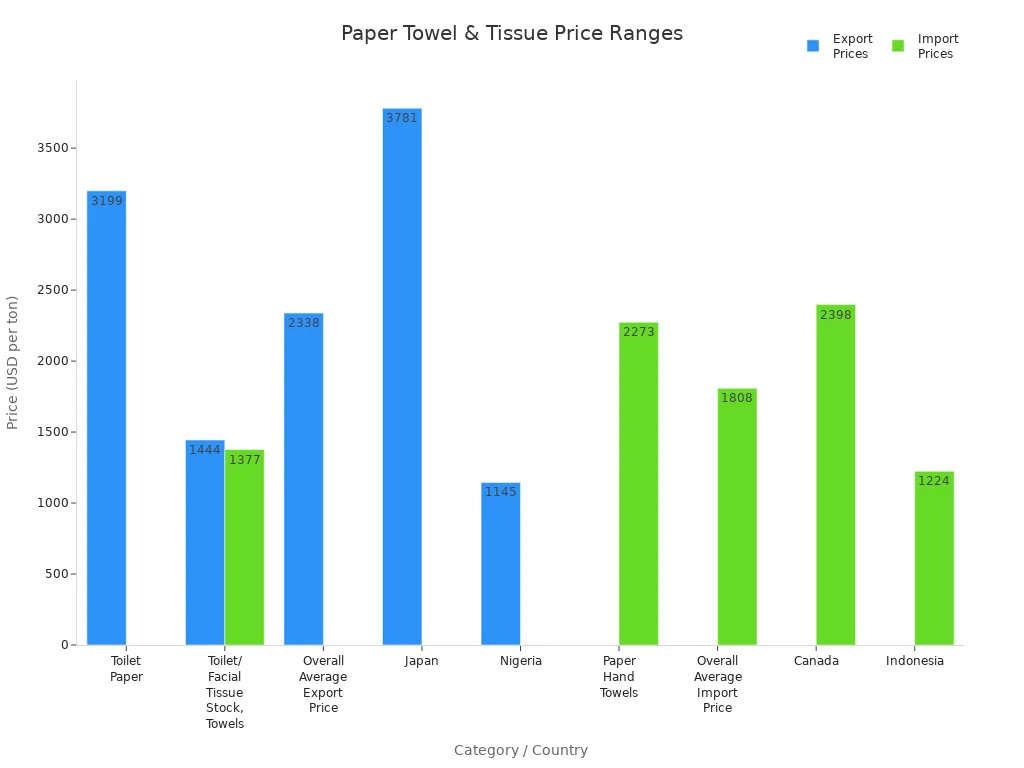
Prices for paper towels and tissue paper can also depend on country. For example, Japan has the highest export prices, while Nigeria and Indonesia have some of the lowest.
Jumbo Roll Economics:
Industrial rolls (width: 2650-3200mm) lower cost by 30% for high-usage facilities like hospitals.
Custom basis weight (15-50gsm) optimizes material use.
Tip: Check the price per sheet or per roll when you shop. This helps you compare value between brands and types.
You want your money to go further when you buy paper towels or tissue paper. Think about how many sheets you need for each task. You might use fewer paper towels to clean up a spill because they absorb more liquid. One or two sheets can handle a big mess. Tissues work best for your nose or face, but you may need more sheets if you try to clean with them.
If you use paper towels for cleaning, you save time and effort. You do not need to grab extra sheets. For personal care, tissues feel softer and break down easily, so you can use them safely on your skin. Some people try to use tissues for cleaning, but they tear quickly. Others use paper towels for their face, but they feel rough.
Volume Reduction: Paper towels require 60% fewer sheets per spill cleanup, offsetting higher per-ton cost ($2,273 vs. $1,444 for tissues).
Here are some ways to get the most out of each product:
Use paper towels for spills, greasy surfaces, or drying hands.
Use tissues for your nose, face, or gentle wiping.
Do not use paper towels in place of toilet paper.
Choosing the right product for each job helps you save money and get better results. You also reduce waste when you use the right amount each time.
Your choices matter when you pick paper towels or tissue paper. How these products are made can hurt or help nature. They can affect forests, water, and the air around us. Many companies now use wood from forests that are managed well. For example, Huaxin Global Co., Ltd. uses FSC-certified virgin wood pulp. They also recycle almost all the water they use. This helps save trees and water.
You can compare their carbon footprint in this table:
| Product | Carbon Footprint (grams CO₂ per unit) | Cost (USD per unit) |
|---|---|---|
| Tissue | 2.55 | 0.01 |
| Paper Towel | 5.00 | 0.03 |
Paper towels make more carbon than tissues. If you buy recycled paper towels, you help lower this number. Some brands plant new trees for every tree they use. New packaging uses kraft paper or recycled plastic to make less trash. Many companies want to use more recycled stuff and help forests stay healthy.
Tip: Check for FSC or BPI labels on the package. These show the product is made in a way that helps the earth.
You want products that break down after you use them. Both paper towels and tissue paper made from natural fibers will break down in compost. Paper towels turn into compost if they do not have chemicals on them. Tissues also break down well, especially if they are plain and have no dyes or scents.
This table shows what you can compost:
| Category | Accepted for Organics Recycling | Not Accepted for Organics Recycling |
|---|---|---|
| Paper Towels & Napkins | Food-soiled paper towels and napkins are accepted | Paper towels or napkins used with chemical-based cleaners are not accepted |
| Tissue Paper & Wrapping Paper | Not accepted | Wrapping paper, gift wrap, packing paper, and tissue paper are not accepted |
| Paper Rolls | Paper towel and toilet paper rolls accepted (recycling preferred) | N/A |
Note: Compost paper towels only if they have food on them. Do not compost tissues or paper towels with chemicals. Always look for compostable labels.
You help the earth when you pick products that are easy to compost and made with care.
You may think about using paper towels as toilet paper or tissues for cleaning. Experts say this is not a good idea. Each product is made for a certain job. Using the wrong one can cause problems. You might feel uncomfortable, hurt your pipes, or even risk your health.
Here is a table that shows what happens if you swap paper towels and toilet paper:
| Aspect | Paper Towels Used as Toilet Paper | Toilet Paper Used as Paper Towels |
|---|---|---|
| Comfort | Feels rough, can make your skin sore | Soft, made for your body |
| Plumbing Safety | Breaks down slowly, can block your pipes | Breaks down fast, safe to flush |
| Hygiene | Not made for your body, may leave bits behind | Made to be gentle and soak up |
| Cost | Costs more for each sheet | Cheaper per sheet |
If you use paper towels as toilet paper, your skin may get sore. Paper towels do not fall apart in water like toilet paper. This can block your pipes and cost a lot to fix. Tissues are soft, but they also do not break down fast. Flushing tissues can clog your pipes. If you use toilet paper to clean, it rips easily. Toilet paper is not strong enough for wiping counters or spills.
Some paper towels have things like bleach or dyes. These can be bad if you use them with food or on your skin. Always check if your paper towels are safe for food. Never use printed or treated paper towels in the oven or microwave. They could burn or let out bad stuff.
Tip: Use toilet paper for your body. Use paper towels for cleaning. Use tissues for your nose or face.
Experts say you should always pick the right product for each job. Kitchen tissue rolls are best for cleaning. They are thick, strong, and soak up a lot. Do not use them as toilet paper. Toilet paper is thin and soft. It is made for your skin. It is not strong enough for cleaning or soaking up spills.
Here is a table with expert advice:
| Tissue Paper Type | Intended Use | Key Features and Expert Recommendations |
|---|---|---|
| Kitchen Tissue Rolls | Cleaning, kitchen use | Thick, strong, soaks up a lot; great for cleaning and spills; not good for your body because they are too rough. |
| Toilet Paper | Personal hygiene | Thin, soft, made for your skin; not strong enough for cleaning; do not use instead of kitchen tissue rolls. |
Studies show paper towels clean more germs from hands than cloth towels. This is why they are good for drying hands in hospitals. Always use paper towels for cleaning and drying hands. Use toilet paper only for your body. Tissues are best for your nose or face, not for cleaning or as toilet paper.
Paper towels: Best for cleaning and drying hands.
Toilet paper: Best for your body.
Tissues: Best for your nose and face.
Note: Do not swap these products. Each one has its own job. Using the right one keeps you safe and helps your home work well.
You have learned that paper towels are strong and soak up spills. Tissue paper is soft and feels nice on your skin. When you pick which one to use, remember these things:
Pick absorbency and strength for cleaning messes.
Choose comfort and softness for your face or hands.
Think about how much it costs and how it is packed.
Look at how it affects the earth, like if it uses recycled stuff or makes a lot of trash.
Try to use less paper when you can. Choose recycled or bamboo kinds if possible. Stay away from products with strong chemicals. These small choices help the earth and save you money in the long run.
Modern jumbo roll producers offer:
Antibacterial Treatment: Silver-ion infused rolls for medical environments.
Sustainable Options: FSC/PEFC-certified bamboo rolls with 100% compostability.
Strength Customization: Wet strength additives from 5-50 N/m based on end-use.
Huaxing Global Jumbo Roll Parameters:
• Width Range: 2650-3200mm.
• Basis Weight: 15-50gsm customizable.
• Fiber Composition: 100% virgin pulp or 30-70% recycled content.
• Wet Strength: 5 N/m (rapid-dissolve) to 50 N/m (industrial wipes).
• Certifications: ISO 9001, FDA 21 CFR, FSC Mix.
You can compost plain paper towels and tissue paper if they do not have chemicals or grease. Food-soiled paper towels break down well in compost. Avoid composting tissues with lotion or strong scents.
Paper towels use more raw material and need special processing for strength and absorbency. This makes them thicker and more expensive per sheet. Tissues use less material and focus on softness.
You should not use paper towels on your face. They feel rough and may irritate your skin. Tissues are softer and made for gentle use on your nose or face.
Tissue paper breaks down quickly in water. This helps prevent clogs in pipes. Paper towels stay strong when wet and can block plumbing if flushed.
Look for labels like FSC or EU Ecolabel. These show the product uses responsibly sourced materials and follows eco-friendly practices. You can also check for recycled content or biodegradable claims.